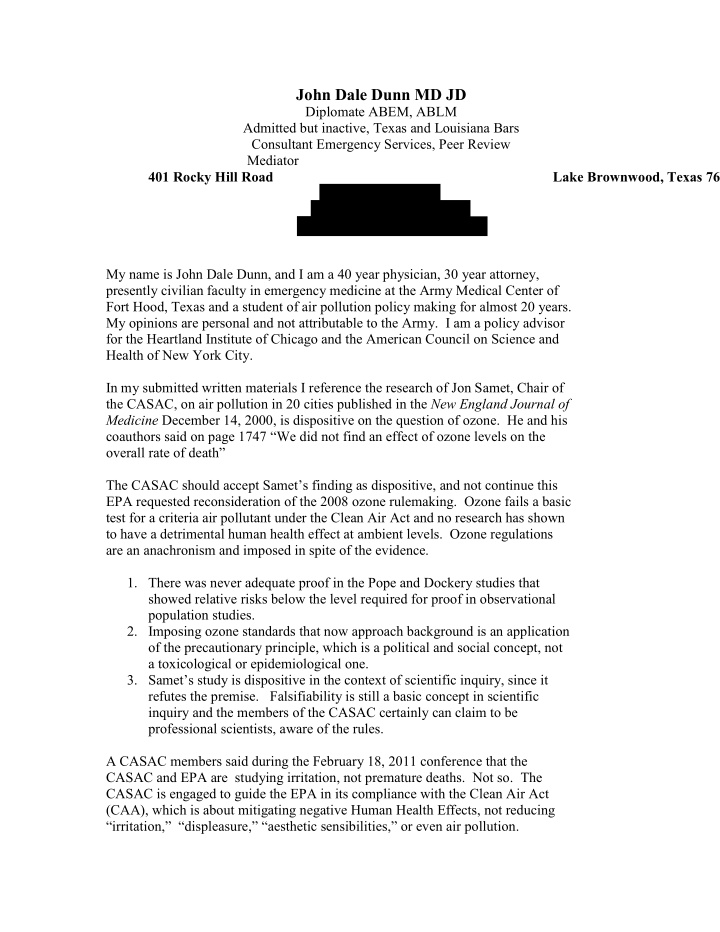



John Dale Dunn MD JD Diplomate ABEM, ABLM Admitted but inactive, Texas and Louisiana Bars Consultant Emergency Services, Peer Review Mediator 401 Rocky Hill Road Lake Brownwood, Texas 76 My name is John Dale Dunn, and I am a 40 year physician, 30 year attorney, presently civilian faculty in emergency medicine at the Army Medical Center of Fort Hood, Texas and a student of air pollution policy making for almost 20 years. My opinions are personal and not attributable to the Army. I am a policy advisor for the Heartland Institute of Chicago and the American Council on Science and Health of New York City. In my submitted written materials I reference the research of Jon Samet, Chair of the CASAC, on air pollution in 20 cities published in the New England Journal of Medicine December 14, 2000, is dispositive on the question of ozone. He and his coauthors said on page 1747 “We did not find an effect of ozone levels on the overall rate of death” The CASAC should accept Samet’s finding as dispositive, and not continue this EPA requested reconsideration of the 2008 ozone rulemaking. Ozone fails a basic test for a criteria air pollutant under the Clean Air Act and no research has shown to have a detrimental human health effect at ambient levels. Ozone regulations are an anachronism and imposed in spite of the evidence. 1. There was never adequate proof in the Pope and Dockery studies that showed relative risks below the level required for proof in observational population studies. 2. Imposing ozone standards that now approach background is an application of the precautionary principle, which is a political and social concept, not a toxicological or epidemiological one. 3. Samet’s study is dispositive in the context of scientific inquiry, since it refutes the premise. Falsifiability is still a basic concept in scientific inquiry and the members of the CASAC certainly can claim to be professional scientists, aware of the rules. A CASAC members said during the February 18, 2011 conference that the CASAC and EPA are studying irritation, not premature deaths. Not so. The CASAC is engaged to guide the EPA in its compliance with the Clean Air Act (CAA), which is about mitigating negative Human Health Effects, not reducing “irritation,” “displeasure,” “aesthetic sensibilities,” or even air pollution.
The Clean Air Act was misnamed and that has resulted in even CASAC member confusion. It should be considered the Safe Air Act, since there is no way with any technology that we can make the air clean. The Act is intended to mitigate air pollutants that harm humans not just make everybody happy that we are reducing pollution. Pollution will always be in the air. Another CASAC member said that studies that show no death effect from air pollution are a “red herring,” but again that is not so. Jon Samet’s research that shows no death effect from ozone is right on point, not a red herring. Premature deaths is probably a poor end point on air pollution research, but it is the only one available and used customarily by the researchers, so studies that show “minor associations” (no death effect) are relevant. Studies that show small effects below the threshold for proof are just that, not proof of anything. EPA studies used to justify regulations seldom if ever provide proof of anything, as defined in the Federal Reference Manual Chapter on Epidemiology and no further regulations should be implemented until the studies meet these standards, at a minimum. The CASAC knows these small effects studies are not proof of morbidity or mortality in observational population studies, and could be effects from confounders, or unknown co factors or data dredging for more a positive result. Why would researches do this? Simply for the publication and funding. Showing potential premature mortality is today’s trigger for additional funding. This funding is the only driving force left for researchers as we have cleaned up the real hazards to health and without new “phantom menaces” to scare the public, funding for research in this market ceases to be needed. There is no disease caused by ozone, and no valid evidence of any premature death effect. High inspired(I cannot figure out what is meant by “high inspired”) ozone studies show variable pulmonary function effects that are extremely small, and reversible. That’s not disease that meets the requirement of the CAA. Ozone regs appear at this point to be arbitrary and unreasonable. When a leading researcher like Samet finds no ozone effect, why are we considering another reduction in ozone air standards on top of a change in 2008? This current reconsideration on ozone is an inappropriate and arbitrary action by the EPA, reworking, for political reasons and without any new science, the 2008 findings. Administrator Jackson should not misuse the CASAC to create cover for an agency decision that is so petulant and political. I would suggest that after a complete and fair review on ozone, Administrator Jackson will have strong evidence to rescind all ozone regulations, since ambient ozone levels are not toxic by any reasonable scientific measure. I ask that the CASAC recommend that Administrator Jackson withdraw her "reconsideration" of Ozone NAAQS proposal and set up the normal statutory complete
and new review with the goal an honest and complete assessment of ozone, that I think will compel the CASAC to recommend that ozone be taken off the list of criteria air pollutants. John Dale Dunn MD JD Emergency Physician Policy advisor Heartland Institute of Chicago and American Council on Science and Health of New York City
Recommend
More recommend